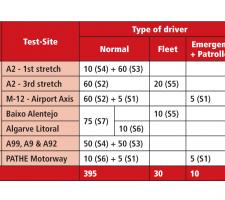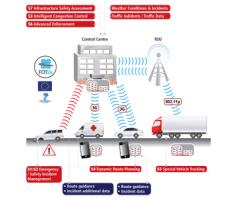Several developments have conspired to push the vehicular side of cooperative infrastructures/cooperative ITS to the fore in recent years. The automotive industry’s rather shorter product development and lifecycles combined with economic slowdown in many regions gave rise to the notion that the greatest advances being made in vehicle-borne technology. Perhaps more damming was it fostered the idea that if we expect to see any meaningful deployment of cooperative systems in the near term then vehicle manufacturers may as well, quite literally, go it alone.
This is flawed thinking in many respects. Whilst it is undeniable that significant safety and traffic management improvements can be derived from a vehicles-only deployment, to achieve the full benefits of the concept still needs input from the infrastructure side. Moreover, while the development of vehicular technology has carried on apace in recent years, this does not mean that we can expect an immediate realisation of the features it can offer. From 2015 we can expect to see vehicles on our roads with the 802.11p connectivity which will facilitate Vehicle-to-X applications but it will take many years to achieve saturation of national vehicle fleets. So, we may be better served by considering again the contribution that infrastructure operators can make and, far from dismissing the vehicle’s contribution entirely, look at how faster delivery of cooperative ITS services might be brought about through the use of smart nomadic devices.
Project background
Such thinking is behind the FOTsis project, one of two integrated projects authorised under theFOTsis has its background in the earlier OASIS project which was the inspiration of a group of private road operators in Spain. It is looking to take the concepts explored within OASIS and see if they can be implemented on a pan-European scale in line with the European Union’s (EU’s) ITS Action Plan and Directive.
“Since roughly the turn of the century, the European Commission [EC] has been emphasising the use of ITS to improve safety, traffic flows and, more lately, emissions. It put in place and provided financing for a series of research projects but these concentrated in the main on vehicles – up until 2009, there was very little involvement in such development work from the infrastructure side,” says the European Road Federation’s Konstandinos Diamandouros, FOTsis’s information dissemination leader.
“In part this was because infrastructure stakeholders tend to have longer-term timespans to consider and be somewhat slower to adapt but it was recognised that their involvement would result in a richer set of cooperative ITS applications. A response to the EC’s FP7 call was made in April 2010 and FOTsis went live a year later. It will run for 42 months until October 2014.”
FOTsis focuses on road operators and their Traffic Management Centres (TMCs), rather than on vehicles. It will promote services already tested from a vehicle perspective but look at them from a road operator’s point of view. Within that work, it will look at road operators’ ability to communicate to road users irrespective of the vehicles that they are being used.
Technology considerations
“Smart devices and a range of protocols including 3G cellular telephony, WiFi and 802.11p combined with roads operators’ access to superior real-time data on local traffic conditions and weather will allow us to enrich already existing applications,” Diamandouros continues. “FOTsis takes us away from the commonly held belief that roads are just asphalt and barriers. They’re much more than that in technology terms. It also addresses, in light of the economic crisis which continues to affect many EU countries, the cost of implementing new infrastructure and technology. This has hit some EU Member States very hard, to the extent that the EC has looked at proposals for a pan-European road pricing strategy. Technologies such as Variable Message Signs (VMS), for example, continue to be seen as useful for real-time information dissemination but they are also increasingly seen as expensive – perhaps too expensive. An alternative is to look at pushing information out through smart devices, which have the additional benefit of being reachable over a much wider geographical area.”
A point to remember, he notes, is that the members of the FOTsis project are in the main private road operators, who by necessity will consider the business case and utility to customers for any new technology. However, the results of FOTsis should also feed into future best practice on publicly owned roads. The result should be a virtuous cycle of increased uptake and lower system cost.
Social inclusivity
The use of smart nomadic devices is not merely an attempt to latch onto a trend but to address the potentially slow rate at which in-vehicle solutions will achieve ubiquity.Diamandouros: “We face a situation in some Southern European countries at present where car-owners are literally handing back the keys. In the face of savage economic cutbacks and high unemployment, they simply can’t afford to run a car – any car. So the idea that we’re suddenly going to see a majority of cars on the road with the latest connectivity just doesn’t hold water. But the FOTsis route to deployment essentially says, ‘If you can afford a smartphone, you can enjoy the benefits of cooperative ITS’. Smart phone prices are falling all the time and they can now be had for around €300. The price point for entry is therefore much more realistic. We’re not necessarily looking to replace the car but to pursue a more socially inclusive model.”
Project recruitment and timescales
FOTsis will use test communities in four countries – Germany, Greece, Portugal and Spain – and will involve over 400 drivers (see Table 1) to test seven use cases or ‘Services’ (see sidebar) in real-world conditions. The communications architecture for the project was complete last year, initial pilot tests have been completed and recruitment of volunteer drivers has commenced. Some of the use cases will use road operators’ own employees as testers – Services 1/2, which deal with emergency response and incident management, being a prime example. Others will have to rely on recruitment from among the general public– Service 3, which deals with intelligent congestion control provides an example. The FOTsis team has been coordinating with, amongst others, the Real Automóvil Club de España (RACE, the Royal Automobile Club of Spain) in order to source interested parties, Diamandouros says.“Recruitment has been very much linked to service need, so for example for freight-related work we’ve been in contact with the IRU [the International Road Transport Union] to help find participants,” he explains. Initial deployments were ongoing at the point that this article went to press and go-live is anticipated as soon as possible thereafter.
FOTsis test applications
The FOTsis project will test the following applications:
Services 1/2 – Emergency/Safety Incident Management
This is essentially eCall but FOTsis will add value from the infrastructure side in that a message will be sent to the TMC at the same time as one goes to the emergency services. The road operator can despatch on-road personnel to start incident management procedures, ensuring that emergency first responders are better informed of the situation by the time they arrive on-scene. At the same time, the TMC can provide the emergency responders with real-time guidance, facilitating their faster arrival.
Service 3 – Intelligent Congestion Control
Congestion management is improved by moving away from the sole use of VMS to provide travel information to the use of VMS and smart nomadic devices.
Service 4 – Dynamic Route Planning
This is similar to the real-time dynamic guidance of first responders during incidents but expands the concept to all road users, taking advantage of the TMCs’ greater knowledge of local road and weather conditions.
Service 5 – Special Vehicle Tracking
A facility for fleet customers, this will offer improved/dual-redundant tracking of Hazmat and over-sized loads. In the case of an incident, road operator response is greatly speeded.
Service 6 – Advanced Enforcement
Principally aimed at countering speeding; instead of using VMS to warn drivers that they are going too fast, warning messages are sent to individuals’ nomadic devices.
Service 7 – Infrastructure Safety Assessment
Irregular driving patterns, such as sharp braking and other manoeuvres, will be monitored to gauge where there are infrastructure issues which need to be addressed, such as potholes or poor skid resistance.














